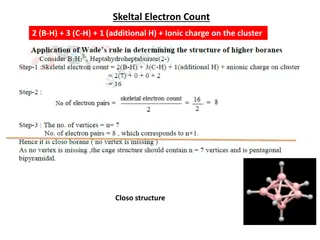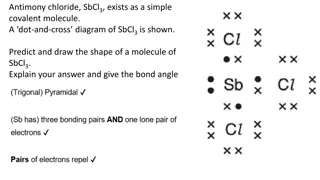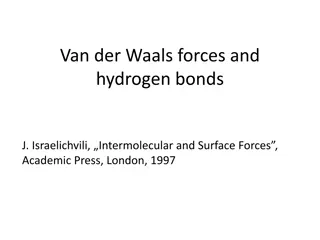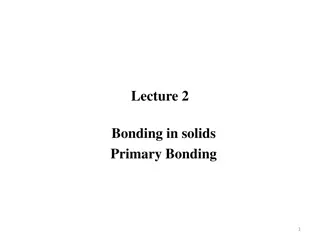
Channel Bonding Proposals for IEEE 802.11-16 Standard
This document from January 2016 outlines proposals for channel bonding in the IEEE 802.11-16 standard, addressing medium access, issues, and solutions related to channel bonding. It discusses the use of RTS and CTS frames for negotiating channel bandwidth and compatibility with legacy devices, along with carrier sense considerations for primary and non-primary channels.
Download Presentation

Please find below an Image/Link to download the presentation.
The content on the website is provided AS IS for your information and personal use only. It may not be sold, licensed, or shared on other websites without obtaining consent from the author. If you encounter any issues during the download, it is possible that the publisher has removed the file from their server.
You are allowed to download the files provided on this website for personal or commercial use, subject to the condition that they are used lawfully. All files are the property of their respective owners.
The content on the website is provided AS IS for your information and personal use only. It may not be sold, licensed, or shared on other websites without obtaining consent from the author.
E N D
Presentation Transcript
January 2016 doc.: IEEE 802.11-16/0098r0 Channel bonding proposals Date: 2016-01-18 Authors: Name Assaf Kasher Affiliations Address Phone email assaf.kasher@intel.com carlos.cordeiro@intel.com Carlos Cordeiro Solomon.triaining@intel.c om lauren.cariou@intel.com Solomon Trainin Laurent Cariou Submission Slide 1 Assaf Kasher, Intel
January 2016 doc.: IEEE 802.11-16/0098r0 Abstract This document describes the basics of channel bonding medium access, discusses issues and proposes a solution to them. Submission Slide 2 Assaf Kasher, Intel
January 2016 doc.: IEEE 802.11-16/0098r0 TXOP extensions for channel bonding (1/2) Use RTS and DMG CTS frames to allow EDMG STAs to negotiate channel bandwidth and be compatible with legacy STAs The RTS is transmitted on available channels and indicates which channels are intended to be used by initiator Recognized by legacy devices A device can be open only to a single channel and receive all the information Data and ACK frames are transmitted in channel bonding format, but with legacy header. Example 2: Example 1: TXOP duration TXOP duration CF - End CTS- to-self RTS CTS DATA BACK DATA BACK CF - End RTS CTS CTS- to-self RTS Submission 3
doc.: IEEE 802.11-16/0098r0 TXOP extension for channel bonding (2/2) DMG CTS shall be sent in a subset of the channels in which the RTS was sent The CTS frame contains an indication of which channels it is sent on DMG CTS is sent over channels which were available before the RTS was sent (more in the next slide) Sent on primary channel if NAV is 0 in the responder Sent on a non-primary channel if there was no energy in that channel As in 11ac, this requires DMG CTS transmitter to be exposed to secondary channel carrier sense enough time to indicate idleness of the channel Encourage use of CF-End to reset NAV on third party STAs >Interval RTS-P Data RTS SIFS CTS BACK CTS-P Submission 4
doc.: IEEE 802.11-16/0098r0 Carrier sense considerations Current 2.4/5GHz requirement is to perform full carrier sense (physical and virtual) on primary channel and energy detection only on non-primary channels NAV behavior only applies to primary channel Energy detection threshold for non-primary channel is 20dB higher 11ay might want to use this same approach and also consider aspects such as better sensitivity Consider approaches such as GI or CP detection in order respect signals that are around sensitivity and not 20dB above it Current 2.4/5GHz requires PIFS idleness on non-primary channels to enable channel bonding transmission 11ay should consider using a sensing period that is at least PIFS long 11ay might want to consider aspects of directivity impact on decision about secondary channel availability Consider approaches like energy pattern detection Submission 5
doc.: IEEE 802.11-16/0098r0 What is the CCA level Maintaining NAV on more than one channel is problematic The standard only specifies CCA energy level and how long the energy has to be there for detection Also missed detection probability CCA level for non-primary channel: sensitivity sensitivity + XdB sensitivity + 20dB (current level for energy detection, range reduced by a factor of 10) CCA level can be decreased by using methods (implementation) such as GI detection and CP correlation. These become harder when there is a range of GI and CP lengths. Submission
doc.: IEEE 802.11-16/0098r0 Channel bonding wakeup? To support channel bonding, the responder needs to be open over multiple channels before the transmission of the RTS so that it can obtain a valid CCA It is undesirable for a device to be open for long periods over multiple channels Higher power consumption Susceptibility to interference from the non-primary channels We propose to transmit a control frame (e.g., Grant frame) to indicate intent to perform channel bonding transmission Receiver could choose to only open to multiple channels after receiving such frame Transmitted at most x microseconds before the RTS/DMG CTS exchange Submission
doc.: IEEE 802.11-16/0098r0 Grant frame for channel bonding wakeup If using Grant frame, could use control trailer (11- 16/105r0) to indicate intended bandwidth and timing of channel bonding Aside from this, rules for Grant/Grant Ack frame transmission would largely remain the same as in 11ad STA A respond with CTS in all channels sensed as idle. Trailer represents STA A actual bandwidth Grant frame sent by STA A to STA B STA A gets RTS in primary channel STA A sensing in channel BW signaled in trailer of Grant frame Dynamic Allocation Info STA A Primary Frame control BF STA A sensing in primary channel only Duration RA TA Control FCS Trailer CTS Trailer STA A Secondary Grant frame received by STA B RTS Trailer CTS Trailer STA B sensing in channel BW signaled in trailer of Grant frame Dynamic Allocation Info Frame control BF STA B sensing in primary channel only Duration RA TA FCS Trailer STA B Primary STA B transmits data PPDU with channel BW indicated in CTS trailer Control RTS Trailer CTS Trailer STA B Secondary End of transaction RTS Trailer Expected start of new transaction. Start of random BOFF STA B wins the access and sends RTS in all channels sensed as idle. Trailer represents STA B actual bandwidth STA B gets CTS in primary channel Duration + Duration Allocation communicated in Grant frame Submission 8
doc.: IEEE 802.11-16/0098r0 Summary Summarized the basic principles of channel bonding so that they can be formally captured in the SFD Proposed MAC concepts to enable channel bonding while keeping backward compatibility with DMG operation Proposed a channel bonding wakeup mechanism to allow for better power saving Submission 9
doc.: IEEE 802.11-16/0098r0 Straw polls / motion Insert the following in the SFD: For 11ay channel bonding, the following apply: 1) Full carrier sense (physical and virtual) shall be maintained on primary channel 2) An EDMG STA may transmit a frame to a peer EDMG STA to indicate intent to perform channel bonding transmission to the peer STA. This allows an EDMG STA to choose to operate over multiple channels only after receiving such a frame, thus saving power. Submission 10






















